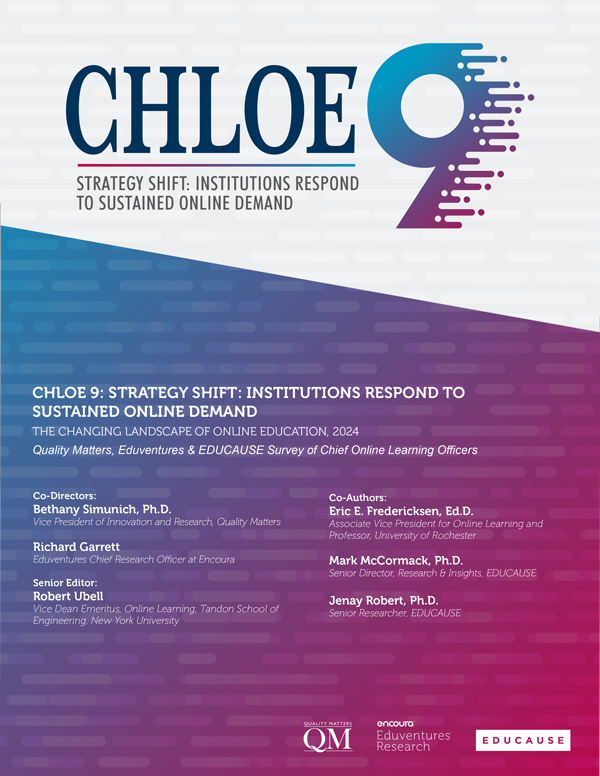2024 CHLOE 9 Report
August 13, 2024
CHLOE 9 | Strategy Shift: Institutions Respond to Sustained Online Demand
The ninth installment of the Changing Landscape of Online Education (CHLOE) report, produced by Quality MattersTM , Eduventures® and Educause — offers an overview of the current state of online learning in higher education as well as insights into its future development. The report was compiled by surveying chief online officers (COLOs) — the professionals best situated to assess the current state of this ever-developing field — at U.S. two- and four-year colleges and universities.
The majority of survey participants report both learner demand for online learning surging and institutional strategic priorities shifting to meet this demand, as well as the adaptation to the new presence of AI tools in the academic environment. Notable findings from the 53-page report include:
Priorities for Online Learning: Institutions are increasingly prioritizing the development of online versions of both on-campus courses (69%) and on-campus degrees (65%) in order to meet demand. In terms of their topmost priority, 43% of COLOs chose online versions of on-campus degrees (the majority of public four-year institutions identified this as their top priority), with online versions of on-campus courses selected as the top priority by 39%.
Tuition and Institutional Revenue: …
AI in Higher Education: …
Third-Party Servicers: …
Regular and Substantive Interaction: …
Two-thirds of colleges are prioritizing online versions of on-campus programs, poll finds — from highereddive.com by Natalie Schwartz
The ninth Changing Landscape of Online Education survey offers a glimpse into the distance education marketplace.
Dive Brief:
- Roughly two-thirds of colleges are making it a priority to create virtual versions of on-campus classes and programs, according to an annual survey of chief online learning officers.
- College officials likely see creating online versions of existing programs as easier than launching entirely new academic programs, according to the report.
- However, 48% of chief online learning officers still said their priorities included launching new online programs with no campus equivalent.
CHLOE 9 Report by Quality Matters, Eduventures, and EDUCAUSE Highlights Continuing Shift of Learner Demand and Institutional Strategy Toward Online Learning — from marketwatch.com
Key findings include increased demand from on-campus students for online options, a notable shift in institutional strategies to align with this demand, and the growing use of artificial intelligence in online education.
BOSTON, Aug. 13, 2024 /PRNewswire-PRWeb/ — Quality Matters, EDUCAUSE, and Eduventures Research have released the ninth edition of the Changing Landscape of Online Education (CHLOE) report, compiling the perspectives of chief online learning officers (COLOs) around the United States. CHLOE 9: Strategy Shift: Institutions Respond to Sustained Online Demand reveals a continued increase in student preference for online learning and the strategies institutions are employing to address this demand.
The report also outlines institutional perspectives on a host of other factors contributing to the state of online education, including artificial intelligence, third-party servicers, OPMs and regular and substantive interaction.
Addendum on 8/15/24:
The State of Online Learning | The CHLOE 9 Survey – Part 1 — from onedtech.philhillaa.com by Glenda Morgan
For the uninitiated, since 2017 the CHLOE report has surveyed Chief Online Learning Officers (COLOs) at higher education institutions in the US to map the changing landscape of online education. It has become an invaluable resource in understanding the topography of online learning in the US as well as how it is changing as more institutions move online and that environment becomes more regulated and more competitive.
I found this year’s survey much more engaging than in recent years. Many of the questions asked and the way they were framed address the issues of concern to people managing online learning. There is a lot in the survey, and I am going to break my coverage into two parts. In this first post, I want to cover the more general findings of the survey as well as some of my concerns with it. In my next post, I want to do a deeper dive into what the CHLOE survey reports about outsourcing and OPMs, a topic that we have covered extensively in this newsletter.










